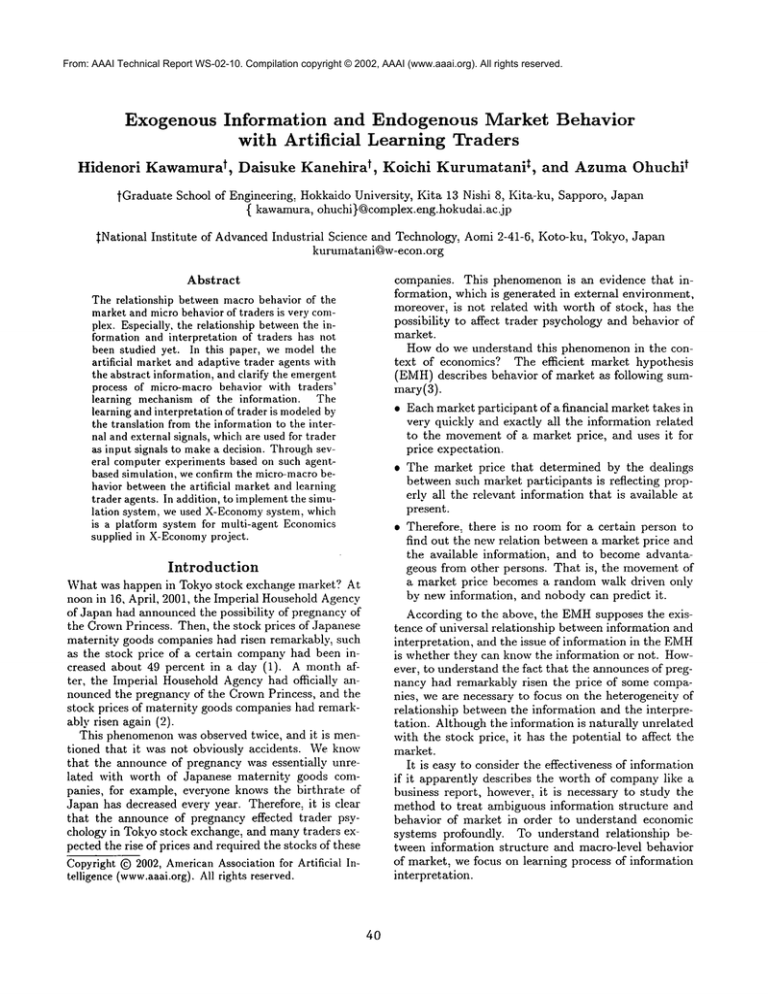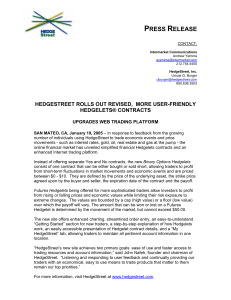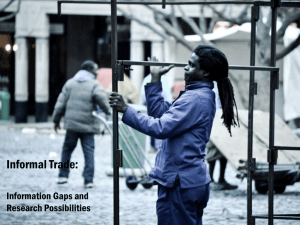
From: AAAI Technical Report WS-02-10. Compilation copyright © 2002, AAAI (www.aaai.org). All rights reserved.
Exogenous
Information
and Endogenous Market Behavior
with Artificial
Learning Traders
t, Daisuke Kanehirat, Koichi Kurumatanit, tand AzumaOhuchi
Hidenori Kawamura
tGraduate
SNational
School of Engineering, Hokkaido University,
Kita 13 Nishi 8, Kita-ku,
{ kawamura, ohuchi}@complex.eng.hokudai.ac.jp
Institute
of Advanced Industrial
Science and Technology, Aomi 2-41-6,
kurumatani@w-econ.org
Sapporo, Japan
Koto-ku, Tokyo, Japan
companies. This phenomenon is an evidence that information, which is generated in external environment,
moreover, is not related with worth of stock, has the
possibility
to affect trader psychology and behavior of
market.
How do we understand
this phenomenon in the context of economics? The efficient
market hypothesis
(EMH) describes behavior of market as following summary(3).
Abstract
The relationship
between macro behavior of the
market and micro behavior of traders is very complex. Especially, the relationship between the information and interpretation
of traders has not
been studied yet. In this paper, we model the
artificial market and adaptive trader agents with
the abstract information, and clarify the emergent
process of micro-macro behavior with traders’
learning mechanism of the information.
The
learning and interpretation of trader is modeledby
the translation from the information to the internal and external signals, which are used for trader
as input signals to make a decision. Through several computer experiments based on such agentbased simulation, we confirm the micro-macro behavior between the artificial
market and learning
trader agents. In addition, to implement the simulation system, we used X-Economysystem, which
is a platform system for multi-agent Economics
supplied in X-Economyproject.
¯ Each market participant of a financial market takes in
very quickly and exactly all the information related
to the movement of a market price, and uses it for
price expectation.
¯ The market price that determined by the dealings
between such market participants
is reflecting
properly all the relevant information that is available at
present.
¯ Therefore~ there is no room for a certain person to
find out the new relation between a market price and
the available
information,
and to become advantageous from other persons. That is, the movement of
a market price becomes a random walk driven only
by new information, and nobody can predict it.
Introduction
What was happen in Tokyo stock exchange market? At
noon in 16, April, 2001, the Imperial Household Agency
of Japan had announced the possibility
of pregnancy of
the Crown Princess. Then, the stock prices of Japanese
maternity goods companies had risen remarkably, such
as the stock price of a certain company had been increased about 49 percent in a day (1). A month after, the Imperial Household Agency had officially
announced the preg~lancy of the Crown Princess, and the
stock prices of maternity goods companies had remarkably risen again (2).
This phenomenon was observed twice, and it is mentioned that it was not obviously accidents.
We know
that the announce of pregnancy was essentially
unrelated with worth of Japanese maternity
goods companies, for example, everyone knows the birthrate
of
Japan has decreased every year. Therefore, it is clear
that the announce of pregnancy effected trader psychology in Tokyo stock exchange, and many traders expected the rise of prices and required the stocks of these
Copyright (~) 2002, American Association for Artificial Intelligence (www.aaai.org). All rights reserved.
According to the above, the EMHsupposes the existence of universal relationship
between information and
interpretation,
and the issue of information in the EMH
is whether they can know the information or not. However, to understand the fact that the announces of pregnancy had remarkably risen the price of some companies, we are necessary to focus on the heterogeneity of
relationship
between the information and the interpretation. Although the information is naturally unrelated
with the stock price, it has the potential to affect the
market.
It is easy to consider the effectiveness of information
if it apparently describes the worth of company like a
business report, however: it is necessary to study the
method to treat ambiguous information
structure
and
behavior of market in order to understand
economic
systems profoundly.
To understand
relationship
between information structure
and macro-level behavior
of market, we focus on learning process of information
interpretation.
4O
¯. External
Environment
J
External Environment
World Information
Internal
Infomation
External
Infomation
Translation
Decision-Making
Order
Market ~ ~: -::
" :
{l:if mmaPt-2 > ImaPt-2, 0 : otherwise}(8)
{l:if Vt-I > I"t-2,0 : otherwise}
(9)
agent k forecasts the next time market price based on
the input signals. In the making an order process, the
agent decides the desirable quantity of kept risky stock,
and makes an order to control the quantity of the stock
based on the comparison with the actual quantity. And
in the learning step, the agent modifies its prediction
factor by the error between the predicted price and the
achieved one in the market.
In detail, the agent k behaves according to the following steps.
Step 1: translate the external and internal
tion to the input signals.
Step 2:
based
Step 3:
stock
forecast the change value of market price
on the input signals.
determine the desirable quantity of risky
in the next time.
Step 4: choice either sell or buy order and decides the
quantity of order according to the difference with the
desirable quantity and actual one.
Step 5: modify the forecasted change value to the realized one.
Translation
and Decision
Making
To translate the information consisting of the external
and internal one, the agent k maps the world information to the input signals. In this agent model, the agent
k simply translates the intarnal information to the in< 10. but, the agent k
put
signals .k =asIj.3 zj< j ....
translates the external information, that is, /1, I2,/3,
to the external signalszl,z2,k .k i3k accordingto the following equations.
f /jRAND{O, 1} otherwise
if rand(O, 1) < ksync
zj¯ k=~
Decision
Making of Trading
Agents
The agent trades for its speculation in the dynamic
market. To make its order to the market, the agent
forecasts the change of market price based on the information. Manyagents possibly use the information for
the prediction of market price behavior, and the information, especially the internal one, are formed as the
emergence of such individual behavior. Therefore, the
information becomeavailable ones for each agent, and
must be the key to analyze the hnk between the micro
and macro level behavior.
The decision making process of an agent, which is
denoted as the agent k, consists of four steps, that is,
translating the world information, forecasting the market price, makingan order, and learning the prediction
factor. In the translating step, the agent k observes the
world information and translates it to the input signals for decision-making. In the forecasting step, the
42
informa-
(10)
where, the function rand(a, b) returns the real value
randomly selected from a to b, and synck(O < sync k <
1) is the parameter of synchronization rate with the external signals. If this parameter is set close to 1, this
agent synchronously maps the external information to
the external signals. If this parameter is close to 0,
this agent ignores the external information, and tries
to utilize ownpersonal information, that is: noise information.
In the viewpoint of macro behavior, if many agents
synchronize to the external information with high values of synck, it is expected that the external information is commonand available one for participant
agents because macro behavior of agents is weakly
linked through its information. On the other hands,
if many agents asynchronously use the external information with small values of synck, the external information must not be commoninformation and becomes
unavailable one for other synchronizing agents. Therefore, we try to analysis the micro-macro structure of
external information in various settings of these values.
After translation of the world information to the input signals (*0,h,...,i~0),
-k -k
the agent k forecasts the
next market price for making an order to the market.
Let kat .k(~0,
if,.
a predicted change value
"" ,i~0) be
the market price in the condition of the input signals
¯ k "k
(%,h,---,i~0),
the predicted change value of market
price betweent - 1 and t is defined as follows.
Table 1: Experimental Settings. In the table, rand(a, b)
is the function to return uniformly randomized real
value from a to b. nrnd(a,b) returns the randomized
value based on the normal distribution with mean a and
distribution b.
,./k
k1/A
"k
akt (z
(11)
0, if,..., iko)
According to the predicted change value, the agent k
can easily decides the des,able quantity of risky stock
as follows.
yk
:
~£ = round(y~l~)
k "k "k
ao
(Zo:zl,---,ifo)
synck (setting 1)
synck (setting 2)
synck (setting 3)
(12)
where, the function round(a) rounds the real value a
to the nearest integer value. The parameter Ak(0 < A)
means the risk averse rate of agent k. If this value is
small, the agent k tries to makea large profit with high
risk. If this value is large, the agent tends to avoid the
risk for losing its property, but this agent can not have
chance to makea large profit.
Next, the agent k makes an order to the market in
order to control the quantity of its risky stock to the
desirable quantity 0~- The order of agent k, otk, is calculated as follows.
=- 4
(13)
If o~ takes negative value, the agent k makes a sell
order, and the quantity of order is -o~. Otherwise, the
agent makes a buy order with the quantity otk. The order price of agent k is simply decided as the predicted
one, Pt-1 + Y~. After all trading agents complete to
make orders, these orders are gathered to the market,
and the market contracts the combination of sell and
buy orders in the equilibrium point that the quantities
of supply and demand are evenly balanced. Then, the
marketprice Pt is fixed, and this price effects the internal information.
Averaged Time
(Std. Dev.)
Exp. i-i
.707.7
(355.9)
Exp. 1-2
834.1
(586.6)
Exp. 1-3
955.6
(52O.O)
where, the parameter 7k is the learning rate of agent
k. If ~,k is set to a small value, the agent k modifies
its learned rate slowly. If ,).k is set to a large value, the
agent k drastically modifies its learned rate according
to the recent chmlge of actual market price.
Experimental Results
Rt = Pt-1 - Pt
(14)
The learning equation of change value defined as follows is apphed to the agent k in each simulation time.
,ilko)
Table 2: The time to converge in each experiment. The
numbers of time are averaged in 15 trials in each experiment. Std. Dev. means the standard deviation of each
trial. In addition, Exp. 1-1 indicates the experiment in
setting 1, Exp. 1-2 is in setting 2, and Exp. 1-3 is in
setting 3.
Experiment
1
In the computer experiment, we prepared the parameter settings shown in Tab. 1. The parameters 7k and
1/Ak are set to independent random values in every
agent. That is, the learning rate and risk averse rate
are heterogeneous in every agent. The initial set of predict factor a~ is set with normal distribution raz~dom
values. The setting of parameter sync k was prepared
three types, i.e., setting 1, setting 2, and setting 3. In
each setting, the value of synck is set to same one in
all agents. The setting 1 is supposed that the market
with the information structure based on entirely same
interpretation, the setting 3 is supposed that the market with entirely independent interpretation:
and the
setting 2 is intermediate of two settings. For the extension, it is able to prepare the set with variety synck but
we did not adopt it for investigation of basic behavior
of proposed model. The main purpose of simulation is
to investigate the effectiveness of information structure
based on such basic settings.
For the first experiment, we focus the convergence
of market behavior. In the proposed model, all trading agents learn with same reinforcement value simply,
and it is expected that the behavior of market price
would converge quickly. In such case, orders of traders
converges to either sell or buy in the condition of information, and the equilibrium point of orders does not
Learning
In order to learn the change value of market price, a
ktrading agent must modi~"the set of change values at
by the result of market behavior. In the learning process, we adopt very simple learning method like that
the predicted change value is modified according to the
actual change value between Pt-1 and Pt.
Let Rt be the reinforcement value, which is the actual change value between time t - 1 and t, and it is
represented as
k
"k -k
at-I-l(lO,#’l,’’’
rand(O, 1)
rand(O, 5)
nrand(O, 10)
0.0
0.5
1.0
k k "k "k
= .)..at(ZOiZl,...,ilko)_t_(l_~/.k).Ri
(15)
43
through the time, namely, the closed system. As the
next experiment, we focus on the situation that the
members of system are not fixed and changed, that
is, the open system. In the open system, the learned
decision-making of agents is changed according to the
stream of members, and the investigation of forming
process in such system is important to clarify the relationship between the information and interpretation in
economic sense. In the experiment 2, the behavior of
open system is investigated in the viewpoint of macro
behavior and information structure.
In the concrete, we prepared 50 traders for the experiment 2 with same settings in experiment 1, i.e., setting
1, 2, and 3. The different point compared with the
experiment 1 is that each trader is initialized its parameters with the probability 3%in each time. It very
simply extends the closed system to the open system
like that some traders go and other ones come in each
time. By the suppose of the open system, the behavior
of market is considered not to converge.
Wecarried out 10 trims with 4000 simulation time
in each settings. Fig. 2 shows the examples of time
series data of market price in one trial of each setting.
It is observed that the behavior of market price did not
converge in each setting but is not observed the different
aspects from these graphs.
Moreover, Fig. 3 show-s the examples of time series
data of the market balance, which represents the balance betw, een the volume of sell and buy orders. The
balance in each time is calculated to divide the volume
of sell orders by the total volumeof both sell and buy
orders. If this value is close to 0 or 1, the balance of orders inclines to the one side. In each graph, the balance
fluctuates around 0.5.
The average and standard deviation of 10 trims data
in each settings is shown in Tab. 3. According to the
results of Tab. 3, the change of market price (standard
deviation of market price) in the setting 1 is larger than
other settings~ also the change of balance (stmldard deviation of balance) in the settings is larger. This phenomenonthat the behavior of market in the setting is
changeable compared with other settings is considered
as based on same reason in the experiment 1. The independent interpretation makes the external information
unavailable, and all traders becometo regard only the
internal information as important. Then, the unbalance
of orders occurred according to the progress of learning.
and the market price is changeable.
As the result of experiment 2, it is indicated that the
situation that the traders have commoninterpretation
of information leads the fertility of macrobehavior and
the dimension of macro level behavior is higher compared with the case of independent interpretation.
It
is difficult to model the relationship between the real
market and real information, and the model used in
this study is too simple to explain the real behavior of
market. However, it is important result that this artificial market model with simple information structure
causes the difference of macro-level behavior.
Table 3: The average and standard deviation of the
market price, and the balace shown in Figs. 2, ??, 3.
The upper number and lower one in each cell represents
the average and the standard deviation,respectively.
Exp. 2-1
AveragedPrice
11416.78
(Std. Dev.)
(1147.03)
Averaged Volume 536.85
(Std. Dev.)
(135.69)
AveragedBalance
0.488
(Std. Dev.)
(0.085)
Exp. 2-2 Exp.2-3
11129.80 10542.78
(828.01) (312.46)
547.68
570.3
(130.43) (136.09)
0.492
0.499
(0.079)
(0.078)
exist. Oncethe market behavior falls into such case, it
can not escape from the convergence.
Weprepared small group of 10 traders with the represented settings and the set of 15 trial simulations w, as
carried out in each settings. Table 2 showsthe time for
achieving the convergence of market behavior in each
setting. Table shows the averaged time for convergence
in 15 trials and the standard deviation. In the results,
the market of setting 1, which consists of traders with
independent interpretation, converged earlier, and the
market of setting 3, which consists of traders w’ith commoninterpretation, converges later. This result is interesting that the time to converge in the setting 1 is
shorter than 3 although the traders in 1 learn based on
independent external signals each other, and the traders
in 2 synchronously learn based on same external signals
each other. In other words, the agent group of setting
1 treats heterogeneous interpretation, and the group of
3 treats homogeneousinterpretation. Simply considering, it seems more difficult to learn in heterogeneous
interpretation than in homogeneousinterpretation.
The reason whythe market in setting 1 converges earlier is considered as follows. In the marketof setting 1,
each trader uses the external signals with independent
translation, and the external signals are unavailable because these can not be linked to the macro behavior and
not be distinguished by the agent. Namely, the traders
in setting 1 learn the prediction in only the conditions
of internal signals, which pattern is 2s. On the other
hands, the traders in setting 3 make a decision based
on the same external signals with commontrmlslation,
and the behavior of market can be distinguished in the
condition of internal signals. Then, the external information becomesto have the worth for the traders, and
the traders learn the prediction in the conditions of the
combinationof external and internal signals, which pattern is 2ll. Therefore, the pattern for learning is less
than in the setting 1, and such difference of information
structure, which is able to be knownfrom the viewpoint
of macro-level, is considered to cause the difference of
convergence between the settings.
Experiment
2
In the experiment 1, the behavior of market converges
because all traders learn based on same reinforcement
learning value and the members of system are fixed
44
12000
11500
11500
11OOO
110(X)
105~
1G~X)
100(X)
1O0OO
9500
950O
9000
T~
(a) Result of experiment 2-1.
.5~X) 1000tSO0200025003000350044X)0
T~
(b) Result of experiment 2-2.
51~100015(X) 2(X)025~030003.~)0
Tm~
(c) Result of experiment 2-3.
Figure 2: Examples of time series data of market price. In each graph, X-axis indicates the number of simulation
time, and Y-axis represents the market price of risky stock.
0.8
o.8
0.6
0.6
0.4
0.4
0.2
0.2
0
Rat;o
1
1
I
5O01000 1500 2OOO
25O03OOO
3500 40OO
Time
(a) Result of experiment 2-1.
0.8
0.6
~
11.4
0
0
T~
(b) Result of experiment 2-2.
500 1000 1500 200025~0 3000 3500 4(XX)
Time
(c) Result of experiment 2-3.
Figure 3: Examples of time series data of the balance in sell and buy orders. In each graph, X-axis indicates the
numberof simulation time, and Y-axis represents the ratio of sell order volume in total volume of both orders. The
ratio is simply calculated to divide the volumeof sell orders by total volumeof both sell and buy orders.
Conclusions
[4] W. Arthur. Designing economic agents that act
like human agents: A behavioral approach to
bounded rationality,
the American Economic Review, 81(2):353-359, 1991.
In this paper, we focus on the relationship between the
information structure and the interpretation in artificial market. In the traditional economics theory like
EMH,it is supposed that the universal interpretation
of information exists in advance, and the importance for
traders is whether it is knownor not. However:in real
world, it is often observed that the information which is
essentially unrelated with the market affects the behavior of market. In one hypothesis, such phenomenacan
be understood that it is supposed the formation process
of of interpretation between leaning trader. According
to the results of simulation, we showthe relationship
between the information structure and macro behavior
of market, although the model is very simple. On the
other words, it is shownthat simple model can lead the
difference of market behavior.
[5} W. Arthur, J. Holland, B. LeBaxon: R. Parmer,
and P. Tayler. Asset pricing under endogenous
expectations in an artificial
stock market. The
Economy as an Evolving Complex Systems, 2:1544, 1997.
[6] B. Edmonds. The use of models - making MABS
more informative. In Multi-Agent-Based Simulation, LNAI 1979, pages 15-32. Springer, 2000.
Messy systems
[7] S. Moss. Editorial introduction:
- the target for multi agent based simulation. In
Multi-Agent-Based Simulation, LNAI 1979, pages
1-14. Springer, 2000.
W. Arthur,
J. Holland,
and
[8] R. Parmer,
B. LeBaron. An artificial stock market. Artificial
Life Robotics, 3:27-31, 1999.
[9] H. Kawamura, A. OhuchL and K. Kurumatani.
Development of X-Economysystem for introduction of artificial
market. In International Workshop on Agent-based Approaches in Economic and
Social Complex Systems (AESCS2001), pages 5158, 2001.
References
[1] The morning paper of Nihon Keizai Shinbun news
paper. Nihon Keizai Shinbun, 17, April: 2001 (in
Japanese).
[2] The morning paper of Nihon Keizai Shinbun news
paper. Nihon Keizai Shinbun, 16, May: 2001 (in
Japanese).
[3] K. Izumi. Complexity of agents and complexity
of markets. In International Workshop on Agentbased Approaches in Economic and Social Complex
Systems (AESCSPO01), pages 43-50, 2001.
45






